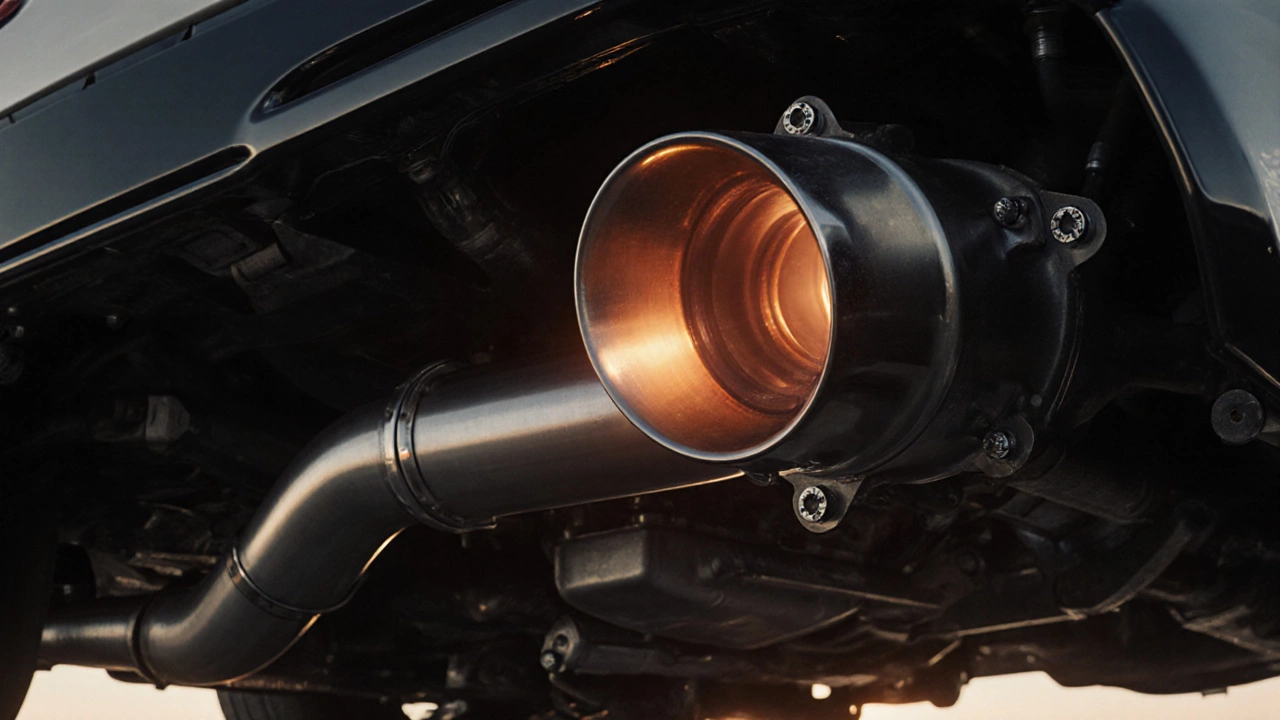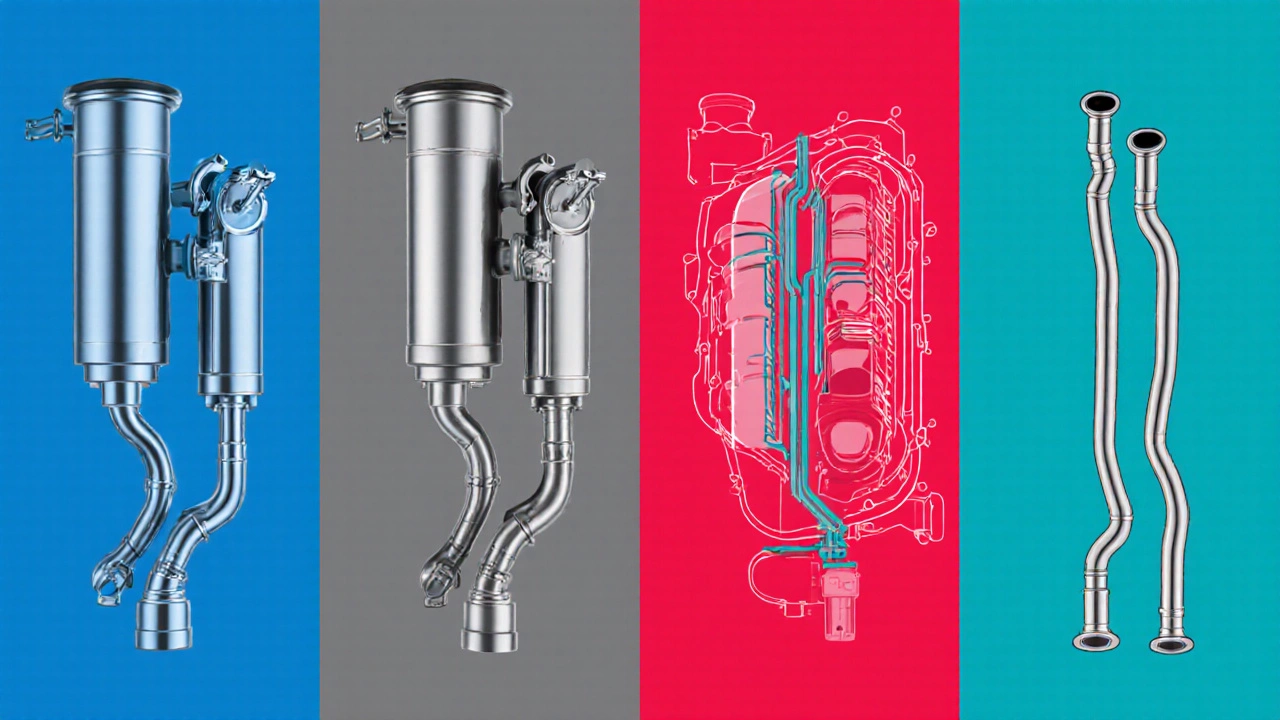 Oct, 16 2025
Oct, 16 2025
Horsepower Gain Calculator
Estimate Your Exhaust Power Gains
Estimated Horsepower Gain:
0 hp
Cost Estimate $0 | Best For:
Key Considerations:
When you fire up the engine, the sound you hear isn’t just noise-it’s a clue about how much power is actually leaving the cylinder. Choosing the right performance exhaust system is one of the fastest ways to squeeze extra horsepower out of a street‑legal car without swapping the engine.
Why an Exhaust Affects Horsepower
Every combustion cycle creates hot gases that must escape. If the path out is too narrow or full of bends, the engine sees higher backpressure, which forces it to work harder to push the gases out. Less backpressure means the pistons can finish their stroke sooner, allowing the crankshaft to turn faster and produce more power. In simple terms, a free‑flowing exhaust lets the engine breathe, and a breathing engine makes more horsepower.
Common Types of Exhaust Systems
- Cat‑back exhaust - replaces everything from the catalytic converter to the tailpipe. It’s the most popular upgrade because it upgrades flow while keeping emissions legal.
- Axle‑back exhaust - swaps only the pipe after the rear axle and the muffler. It’s cheaper but offers less gain than a cat‑back.
- Turbo‑back exhaust - replaces the entire path from the turbo outlet through to the tailpipe. It’s the go‑to for forced‑induction cars that need maximum flow.
- Headers - replace the factory exhaust manifolds with individual tubes that merge downstream. They reduce turbulence right at the exhaust port.
- Performance muffler - redesigns the internal chambers to cut down restriction while still managing sound levels.
How Each System Adds Power
Below is a quick rundown of the physics behind each upgrade:
- Cat‑back uses larger diameter tubing (often 2.5-3.0 inches) and smoother bends. The larger cross‑section reduces velocity pressure, translating to roughly 4-7hp on a typical V‑6.
- Axle‑back mainly improves the muffler section. Gains are modest, usually 1-3hp, but the sound can be dramatically louder.
- Turbo‑back clears the entire exhaust path, allowing the turbo to spin more freely. Real‑world dyno tests show 6-12hp on a 250‑hp turbocharged four‑cylinder.
- Headers create a more uniform pulse as each cylinder’s exhaust gas exits. This can add 5-10hp on naturally aspirated engines, especially those with a short‑stroke design.
- Performance muffler fine‑tunes the trade‑off between sound and flow, often delivering 2-4hp when paired with a larger pipe.

Key Factors That Influence Horsepower Gains
Not every exhaust will give the same boost on every car. Here are the variables you need to watch:
- Pipe diameter - Too big can reduce exhaust velocity at low RPM, hurting torque. The sweet spot usually matches the engine’s displacement and intended RPM range.
- Material - Stainless steel resists corrosion and retains shape longer than aluminized steel, preserving flow over time.
- Mandrel‑bent tubing - Unlike crushed bends, mandrel bends keep the interior diameter consistent, preventing hidden bottlenecks.
- Backpressure vs. scavenging - Some designs intentionally create a mild pressure wave that helps pull out gases (scavenging). Performance exhausts aim for optimal scavenging, not zero pressure.
- Engine tuning - A new exhaust changes the air‑fuel ratio and timing needs. A quick ECU flash or a custom tune can unlock the full horsepower potential.
Real‑World Numbers: What Dyno Tests Show
A recent study by the Canadian Performance Magazine tested four common stock cars with three exhaust upgrades each. The average gains looked like this:
| Exhaust Type | Typical HP Gain | Cost (USD) | Best For | Common Material |
|---|---|---|---|---|
| Cat‑back | 4‑7hp | $500‑$1,200 | Daily driver, mild boost | Stainless steel |
| Axle‑back | 1‑3hp | $300‑$800 | Sound upgrade only | Stainless/aluminized |
| Turbo‑back | 6‑12hp | $1,200‑$2,500 | Turbo cars, track use | Stainless steel |
| Headers | 5‑10hp | $800‑$2,000 | NA engines, high‑rev | Stainless steel |
How to Choose the Right Exhaust for Your Car
Follow this short decision tree before you click “Add to Cart”:
- Is your car naturally aspirated or turbocharged? Turbo cars benefit most from a turbo‑back upgrade.
- Do you need a legal, emissions‑compliant build? Stick with a cat‑back system that retains the catalytic converter.
- What’s your budget? Axle‑back is the cheapest, while custom headers can cost a small fortune.
- How important is sound? Mufflers with straight‑through chambers give a louder, deeper tone, while resonator‑packed designs stay quieter.
- Do you plan to tune the ECU? Pair any major exhaust change with a professional tune to capture the full gain.

Installation Tips and Common Pitfalls
Even the best exhaust won’t deliver its promise if installed incorrectly. Keep these points in mind:
- Torque specs matter - Over‑tightening clamps can warp tubing; under‑tightening leads to leaks. Use a torque wrench and follow the manufacturer’s N‑m rating.
- Check for clearance with the suspension and brake lines. A larger pipe can rub on the subframe during hard cornering. \n
- Seal every joint with high‑temperature silicone or a proper gasket. Exhaust leaks can cause a check‑engine light.
- If you replace the catalytic converter, make sure the new unit meets your province’s emissions standards - Ontario and British Columbia enforce strict rules.
- After installation, run a short break‑in period (about 15‑20minutes) then re‑torque the clamps. This lets the metal settle into its final shape.
Quick Checklist Before You Buy
- Confirm the exhaust type (cat‑back, axle‑back, turbo‑back, headers).
- Match pipe diameter to engine displacement and intended RPM range.
- Choose stainless steel for durability and consistent flow.
- Look for mandrel‑bent tubing, not crushed bends.
- Plan a professional tune or at least a custom ECU flash.
- Verify local emissions compliance if you replace the catalytic converter.
Frequently Asked Questions
Will a louder exhaust always mean more horsepower?
Not necessarily. Sound is mainly a by‑product of how the muffler is tuned. A well‑designed, relatively quiet muffler can still increase flow and add power, while a very loud one might create excess turbulence that actually hurts performance.
Do I need to replace the catalytic converter for more horsepower?
Only if you’re willing to run a “cat‑less” setup, which is illegal in most Canadian provinces. A cat‑back system retains the factory catalytic converter, keeping the car street‑legal while still gaining flow.
How much horsepower can I realistically expect from a cat‑back upgrade?
For most stock V‑6 or four‑cylinder engines, the gain is between 4 and 7hp. Larger engines or those already tuned may see slightly more, but don’t expect a double‑digit jump.
Is a professional tune mandatory after installing a new exhaust?
It isn’t mandatory, but a quick ECU flash can unlock the full power potential and prevent lean‑run conditions that could damage the engine.
Can I install an exhaust myself?
If you have basic hand tools, a torque wrench, and a solid set of jack stands, a cat‑back or axle‑back is doable for DIY enthusiasts. Headers and turbo‑back systems often require professional welding and alignment.
Bottom line: the biggest horsepower boost comes from eliminating bottlenecks where the factory system is most restrictive. For most street cars, a quality cat‑back made from mandrel‑bent stainless steel is the sweet spot between cost, legal compliance, and power. If you have a turbocharged model and can afford it, stepping up to a turbo‑back is the next logical jump.